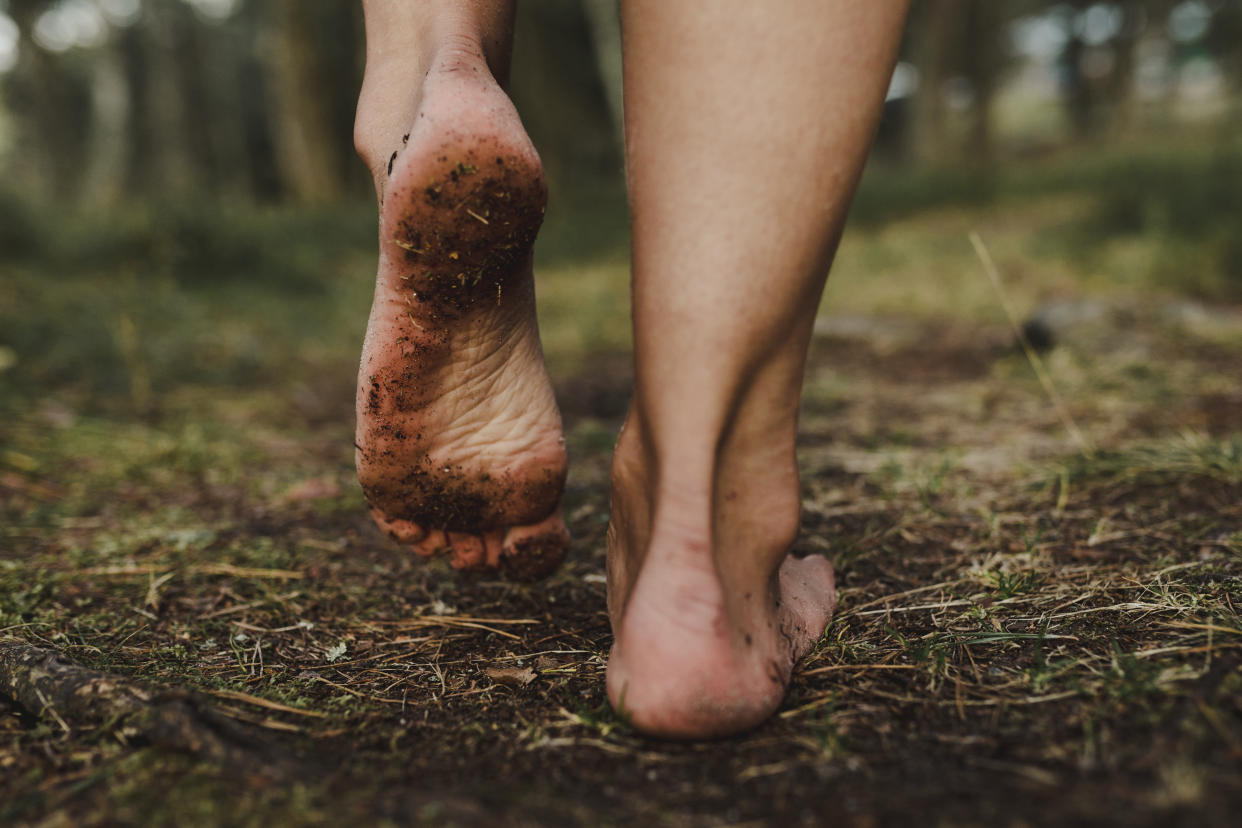'Barefooting' is having a moment on social media. Is walking without shoes good for you?

"Barefooting" — as in, walking around barefoot, even in public — is having a moment on social media, thanks to one creator's viral TikTok video sharing how she and her husband are adapting their lifestyle, and their shoes, in an effort to feel more connected to their environment. The video posted by user Christi Fritz shows the couple removing the soles of their shoes in an effort to "blend in with everyone else" while committing to going barefoot, she says. The video has gained massive attention across multiple platforms, garnering 4.1 million views on X (formerly Twitter) and 50.7 million views on TikTok in one week.
Though some have questioned whether Fritz's video might be satire, other self-proclaimed "barefooters" — among them "The Barefoot Guy," "The Barefoot Human" and "Barefoot Sue" — have carved out space on social media. Some claim that walking without shoes offers mental health benefits similar to those of practices like grounding or earthing (the act of planting your bare feet on grass or the ground), while others discuss improvements to their physical well-being.
A TikTok user who goes by the handle @TheAmazingMara even highlights how she's teaching her children to go barefoot. "Being barefoot is just more natural. It helps improve balance and coordination and strengthens the muscles in your feet," she claims in one video. "Our feet were not meant to be shoved into shoes that change the shape. This should definitely be more socially accepted."
Is that true? Below, experts explore these claims.
Are there benefits to going barefoot?
Going barefoot isn't always a bad idea, according to Dr. Meghan Kelly, assistant professor of foot and ankle surgery at Mount Sinai. She tells Yahoo Life that walking barefoot can strengthen the small muscles within your feet to help with overall stability.
"Strengthening toes and working on their range of motion can have beneficial effects on strength and balance," she says. Instead of focusing on a barefoot lifestyle, however, she suggests participating in some activities that are "best done without shoes," like yoga, Pilates and various forms of martial arts.
"I don’t think it’s necessary to wear shoes at all times," she says. "Low-impact activities can be tolerated well barefoot. ... Many of these activities are excellent to strengthen the feet."
The biggest difference between those activities and what some barefoot content creators are promoting is the environment in which they're going shoeless, she says.
"The vast majority of these activities are performed indoors in a controlled environment to mitigate the infection risk," says Kelly. The same cannot be said for wandering around cities, stores and even beaches or forests. For that reason, wearing shoes should remain standard practice.
What are the biggest risks of going barefoot?
Infection and injury are primary concerns when it comes to the safety and health not only of a person's feet but overall, according to Kelly.
"It is rare in [a city] that you’re not seeing a brown smudge on the pavement and the vast quantity of bacteria from human and animal feces, garbage, etc., is not something you want to expose your skin to or to track into your home," she says. "In general, our skin has an important job to protect us from infection, but if that protective layer gets compromised by, say, stepping on glass or a stone and is surrounded by a significant amount of bacteria, it can lead to a serious infection in the foot."
Variables such as weather also need to be considered, as either hot or cold environments can cause significant harm. "I’ve seen significant burns and frostbite in patients who were not wearing adequate footwear in very hot or very cold weather," explains Kelly. "In some cases, this can lead to amputation of toes and even the entire foot."
There are barefoot-style shoes, otherwise known as minimalist shoes, that are meant to mimic the sensation of being barefoot while reducing the risk of infection. Kelly, however, does not recommend them.
"They don’t offer enough to support for running on hard surfaces such as concrete sidewalks or roads," she says. "I have found that it can lead to stress injuries in the foot like sesamoiditis, metatarsalgia and stress fractures."
It's also important to note that not all feet are created equal.
"If you have fallen arches or flat feet, doing activities barefoot can lead to increased stress in the arch and along the tendons in your ankle," regardless of what that activity is, Kelly says.
The main takeaway
Wearing shoes is the best practice, according to Austin Hall, a podiatrist and foot and ankle surgeon.
"Supportive shoes should be worn whenever possible to help prevent pain and abnormalities throughout the body," he tells Yahoo Life, noting that footwear has an impact on a person's stride. "The gait cycle involves the entire body and especially the lower half. Wearing appropriate, supportive shoes can indirectly help prevent pain by maintaining a normal gait cycle."
The support of the shoes may vary depending on your foot's natural arch. If anyone is considering barefooting because they're having issues with their feet or gait, they should talk to a doctor first, says Kelly.
"It’s important to remember that often social media is highly unregulated and content that is posted may not have been evaluated by professionals," Kelly says. "Furthermore, information can easily be taken out of context. When in doubt, seek out a trusted professional."


